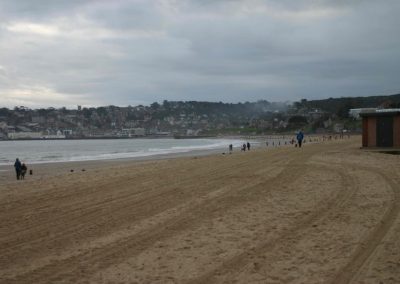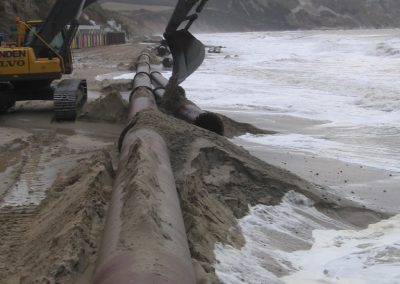Phase 1
Measuring quantities pumped ashore
There are two factors to take into account when estimating the quantity of sand reaching the beach. The amount we claim as pumped ashore is recorded by the dredger and we have to allow for a “bulking factor” of 1.2 due to the material being mixed with water in the hopper. For instance, if we’re told that 3,000 cu.m. has been pumped from the hopper it would equate to 2,500 cu.m. actual material dredged.
We then allow for an estimated 20% of that 2,500 cu.m. being lost to the foreshore during pumping, so only 2,000 cu.m. might be left on the beach.
These figures provide guidelines. Beaches are independently surveyed on a daily basis, comparing levels and widths to a baseline survey carried out before work commenced, and in that way we get a far more accurate idea of how much sand has actually been delivered.
SEE ALSO
Swanage beach replenishment
Beach replenishment work started at Swanage on 22nd November 2005 and was completed on 9th December, after which the sinkerline was floated and moved by sea to Branksome Chine, Poole.
Swanage was due to receive 90,000 m³ of new sand; the 128,219 m³ recorded as pumped ashore allows for various factors (find out more).
Swanage statistics
Swanage Beach | Days | Loads | Cubic metres | Metric tonnes* | Tons |
Total pumped ashore | 16 | 76 | 128,219 | 192,329 | 189,291 |
*The Crown Estate apply a factor of 1.5 to convert cubic metres of sand to metric tonnes, and 1 metric tonne = 0.984206528 long (British) ton.
About the Project
The aim of the new beach is to protect Swanage from coastal erosion but it will also improve the amenity for all residents and visitors. Leaving Swanage beach untouched could lead to damage to local properties and roads over the next 50 years amounting to over £35 million.
Poole Harbour is being dredged to provide the sand needed for the scheme. The 750m long sinkerline (a pipeline that lies on the seabed, used for pumping dredged sand from ship-to-shore) was assembled in Newhaven Harbour in Sussex and towed to Swanage.
As well as replenishing beach sand the project here also involves building new timber groynes to replace the old ones, and to help reduce longshore drift, the main cause of long-term erosion of the beach. The old groynes have been in place for 75 years but are now beyond repair.
Project progress was recorded in a Daily Diary
Before & After Replenishment pictures
Courtesy of Phil Smith, Poole resident; pictures taken very close to the same spot at the same time of day using the same focal length and camera angle
New Groynes
After detailed consideration of a range of different coast protection measures, timber groynes were selected as they take up less space on the beach and there will be little change to the visual appearance of the shoreline. Timber groynes are also cost effective, historically proven to work here at Swanage and there is a general preference for them expressed by the public and landowners through the pre-scheme consultations.
Groyne construction was contracted to Dean and Dyball. We had 18 timber groynes to replace, and aimed to complete the work up to Burlington Chine by Easter, with groynes further north to be completed by the end of May.
All the old groynes to the north of the Outfall Jetty were removed. The two groynes to the south of the Outfall Jetty did not need to be replaced. About 10% of the timber was re-used in the scheme. Some of the rest of the timber was taken away and re-milled for use elsewhere. Timber that could not be recycled was disposed of at a licensed disposal site.
Work was carried out during winter months to avoid disruption to the tourist season. This meant dealing with winter weather as well as difficult tidal conditions at Swanage. To take best advantage of the lowest tides, some of the work took place very early in the morning and quite late into the night.

































